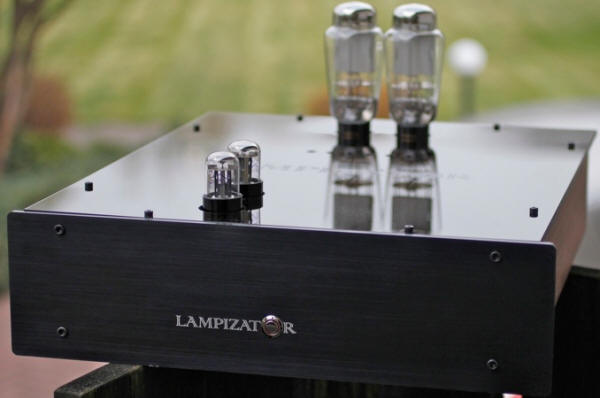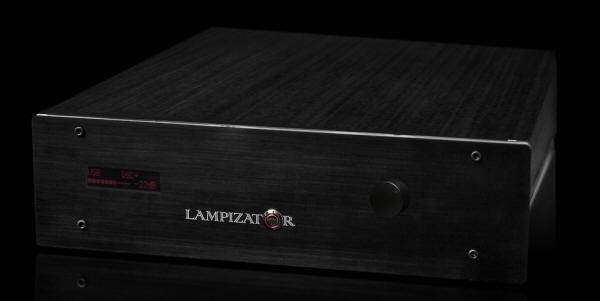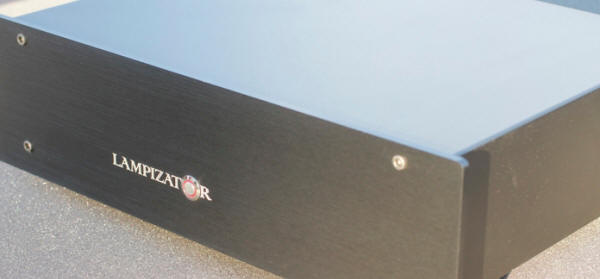You are reading the older HTML site
Positive
Feedback ISSUE 74
The Big 7, and a Chat
with the Lampizator
Lukasz Fikus of Lampizator One of the newer companies making Digital to Analog Converters (DACs) in the audio world is Lampizator. The name comes from a nickname given to company founder Lukasz Fikus, who designs and manufactures his DACs in Poland. "Lampa" is the polish word for vacuum tube, and "The Terminator," well, everyone knows Arnold. The result is that Lukasz Fikus is now known as the Lampizator – as is his company (see picture above). In just a few years, Lampizator has sold over 600 vacuum tube based 2-Channel DACs to audio fans all around the world. Unlike other DACs, Lampizator takes a unique approach to their products. Each one is literally custom made to order after the customer selects a model (Levels 4 to 7) and a series of optional enhancements, including volume control and remote, DSD module, balanced outputs, additional digital inputs, and upgraded output capacitors. Lampizator DACs are made by hand and take anywhere from 3 days (Level 4) to 2 weeks (Big 7) to build and test. The base pricing for the Lampizator DACs start at 2950 Euros ($4150 U.S. Dollars) for the Level 4 Lampizator DAC, all the way up to 7000 Euros ($10,500 U.S. Dollars) for the new top of the line Big 7 Lampizator DAC. (For a detailed review of the Level 4 Lampizator, check Mark Pearson's review in Issue 73 of Positive Feedback Online). Despite the small size of Lampizator, its fame has spread quite rapidly. Lampizator owners are very passionate about the quality of the sound from their DACs, and often urge others to hear the product. It was a treat recently to meet Lukasz Fikus at The Show in Newport Beach, hear him talk about his company, and get a chance to hear a Lampizator DAC in person.
The Lampizator Big 7 DAC The Big 7 Until recently, the top of the line Lampizator DAC was a statement product called the Level 7. It is a 2-box product that features an output stage based on DHT tubes that you would normally find in an amplifier (rather than a DAC) that are directly coupled to the DAC chip for PCM playback. (DSD playback on the Level 7 is available through an optional module). With the new Big 7 DAC, a larger box is used so that all of the circuitry is contained in one box. Other enhancements include more power supply units (20 PSUs in the Big 7 DAC vs. 9 PSUs in the Level 7), bigger rectifier tubes (5C3 and Bendix 5U4R), and standard features including Duelund input and output capacitors. Options for the Big 7 include a DSD playback module (500 Euros, $680 U.S. Dollars) and a volume control plus remote that replaces the need for a separate preamp (1000 Euros, $1360 U.S. Dollars). At The Show in Newport Beach, the Big 7 was paired with two Gingko Audio ClaraVu 7 Mk. III Speakers ($8995), a Wells Audio Innamorata Signature Amp ($13,000), the Lampizator Transport Music Streamer ($2650), and Diamond Reference cables from Dana Cable. Lukasz started the Big 7 demo with some tracks from several albums sourced from PCM. The warm sound of the tube based DAC came through quite nicely for some very fine music listening. Next up, he switched to a different set of files and played some music in Single Rate and Double Rate DSD (DSD64 and DSD128). Lukasz is quite proud of the results of their DSD128 playback module and feels it really shows off the Lampizator DACs, including the Big 7, to their best advantage. I would agree. As nice as the PCM sound on the Big 7 is, the DSD sonics are even better. In fact, at the demo I attended some of the audience members started to leave when the PCM playback ended. But they quickly returned to their seats as soon as the first notes of the DSD music started! This was easily some of the best sound heard during The Show in Newport Beach to my ears.
The Lampizator DSD DAC DSD DAC With the success of the Lampizator line and the optional DSD playback module add-on, Lukasz looked at a dedicated and simplified DSD-only DAC. The result is the new Lampizator DSD DAC that converts DSD to analog using passive filters and active tube circuits. He says that their DSD DAC uses "no digital processing of any kind" and is the most "native DSD" player on the market. Going further, Lukasz says that their DSD DAC will beat "every DAC you ever heard, or your money back." Early reviews of the DSD DAC are just now starting to come in. And they have been very positive. There is also good news for music fans. Due to the simplified circuitry in the DSD DAC, it is priced below the existing Lampizator line (Levels 4 thru 7) at 2490 Euros ($3388 U.S. Dollars).
The Amber DAC from Lampizator Amber DAC Now that the entry level Lampizator models (Levels 1, 2, and 3) have been dropped from the product line, the company looked at offering a new more affordable DAC. The result is the Amber DAC. This DAC uses a printed circuit board vs. handmade construction. It allows Lampizator to cut the time to make a DAC from 2 days for a DSD DAC and 3 days to 2 weeks (Level 4 to Big 7 DACs) to a single day. Lukasz says that the new Amber DAC sounds quite good; in fact he worries that it may be "too good" for the price! It shares a number of features of its higher priced family members, including a quality tube-based power supply and a tube-based output stage. It also offers the ability to add a DSD module, so it can be used either as a dedicated DSD unit (like the DSD DAC model) or as a DAC with both PCM and DSD playback. There are a few trade-offs to consider with the Amber DAC. What it doesn't offer is higher end, "exotic" tubes (as offered in the higher end models), or the optional volume control (the power supply on the Amber DAC doesn't have the power to enable that feature). But then again, the Amber DAC carries a base price of only 1200 Euros (about USD $1640)—less than half the cost of the DSD DAC, the next lowest price DAC in the Lampizator price line. And one more thing. The Amber DAC is not yet available to music fans in North America (U.S. and Canada). So you'll have to wait a bit longer if this is a DAC you'd like to consider. There is one exception though—at The Show in Newport Beach, Lampizator did hold a drawing to give away an Amber DAC. So there's at least one person in North America who has beat the odds and has the Amber DAC in his or her audio rack. Time will tell if that person gets company in the near future. For audio fans outside North America, this is another interesting Lampizator DAC to consider.
What's Ahead – A Headphone Amp With the addition of the Big 7, DSD DAC, and Amber DAC to the Lampizator line, you might think that it would be time for the Lampizator team to take a break. But that's not their style. They continue to keep an eye on what is happening in the DAC market and look at additional options and opportunities. So I asked Lukasz about some new directions in the market and how his company will respond. We talked about the recent availability of a handful of sample music DSD downloads at Quad Rate DSD (11.2MHz, DSD256) and the potential of a few albums on the market in the months ahead, as well as Quad Rate DSD upsampling. While Lukasz is enthused about DSD in general and Double Rate DSD (5.6MHz, DSD128) in particular, it is clear that he is pretty skeptical about the need to go above Double Rate DSD for music playback. However, he did say that some existing customers have asked about the ability of their Lampizator DACs to play in Quad Rate DSD (DSD256), or even higher DSD rates. With that in mind, he is investigating what might be possible to support these rates in current and future Lampizator DACs. Next we discussed the emergence of Multichannel DSD downloads with over 500 albums now available for purchase in that format. Lukasz is aware of this developing segment of the music downloads market. But he says that Multichannel playback for the Lampizator DACs is "not in the current product roadmap." One item that has made it into the product roadmap is the addition of a headphone amp known as the Head DAC. Originally this was going to be an enhancement for current Lampizator owners and buyers that purchased the Volume Control Option. However, as the design work on the headphone amp progressed, Lukasz decided that making it an optional add-on to their DACs was too much of a compromise. He feels that a better approach will be to build a headphone amp from scratch. Design work is now underway on the Head DAC. The new Head DAC brings features of the Level 4 Lampizator DAC and a dedicated headphone amp together in one box. Like most of the earlier Lampizator DACs, the Head DAC will come standard with PCM playback (3900 Euros or $5281.84 in U.S. Dollars) along with an option to add DSD playback as well for an additional 600 Euros ($812.55 in U.S. Dollars). It will be available in August 2014. I'd Like to Hear More I'm glad I had a chance to hear the Lampizator Big 7 DAC and chat with its designer Lukasz Fikus at The Show in Newport Beach. I appreciated his enthusiasm and candor, and came away wanting to hear some of the newer models in their product line. If you're considering buying a 2-Channel DAC for your audio system, I agree with Positive Feedback's Mark Pearson—you will want to give these products an audition. They deserve to be heard.
Lampizator
Lampizator North
America Web Site
Lampizator Big 7 DAC
Lampizator DSD DAC
Lampizator Amber DAC
Lampizator Head DAC
|






